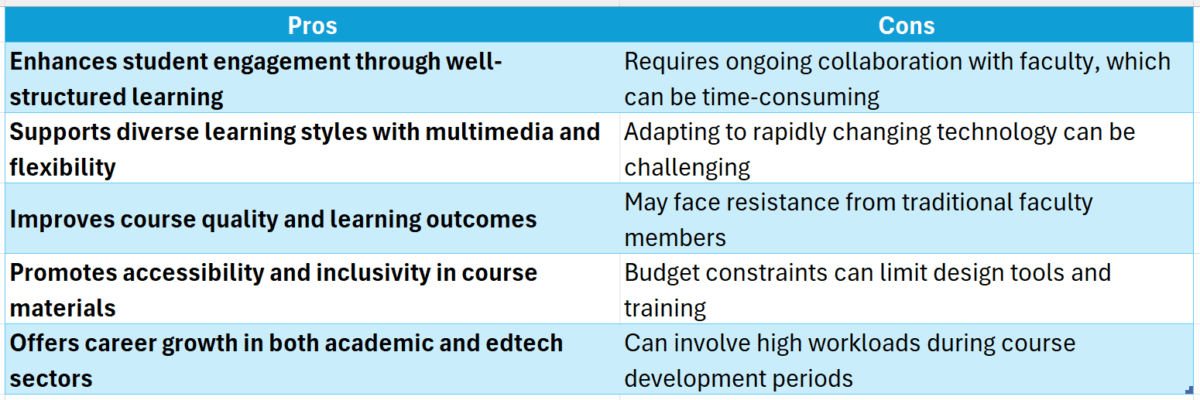
Understanding the role of instructional design higher education is crucial for creating effective learning experiences. These professionals blend creativity with educational theory to develop courses that engage students and meet academic standards. But what exactly do they do? Let’s dive in!
Key Responsibilities of Instructional Designers
- Curriculum Development: They design instructional materials and assessments that align with learning objectives. This often involves creating an instructional design curriculum that is both engaging and informative.
- Collaboration: Instructional designers work closely with faculty and subject matter experts to ensure that course content is accurate and relevant.
- Technology Integration: They incorporate various technologies to enhance learning, making courses more interactive and accessible for students.
Why Instructional Design Matters
A curriculum specialist degree can be a stepping stone for those interested in this field. Instructional designers play a vital role in shaping the educational landscape, ensuring that students receive a high-quality education tailored to their needs. By understanding their role, we can appreciate the impact they have on student success.
Start your journey to a brighter future—Enroll now!
What Skills Do Instructional Designers Need to Succeed?

Instructional designers play a crucial role in higher education, shaping how students learn and engage with material. They create effective instructional design curriculum that meets the needs of diverse learners. Understanding what skills these professionals need can help aspiring designers prepare for a rewarding career.
Key Skills for Instructional Designers
To succeed in instructional design higher education, professionals should possess a mix of technical and interpersonal skills. Here are some essential abilities:
- Analytical Thinking: Designers must analyze educational needs and outcomes.
- Creativity: Crafting engaging and interactive learning experiences requires a creative mindset.
- Communication: Clear communication with faculty and students is vital for collaboration.
- Technical Proficiency: Familiarity with various educational technologies enhances design quality.
Educational Background
Many instructional designers hold a curriculum specialist degree, which equips them with the necessary knowledge and skills. This degree often covers topics like learning theories, assessment strategies, and technology integration, all of which are essential for developing effective instructional materials. By combining education with practical experience, designers can create impactful learning experiences that resonate with students.
How Instructional Design Enhances Student Learning Experiences
Higher education instructional designers play a crucial role in shaping how students learn. They create engaging and effective instructional design curriculum that helps students grasp complex concepts. Understanding what these professionals do can illuminate the path to better educational experiences for all learners.
The Role of Instructional Designers
Instructional designers are like architects for education. They build courses that are not only informative but also enjoyable. Here’s how they enhance student learning experiences:
- Curriculum Development: They design curriculum that meets educational standards and student needs.
- Technology Integration: They incorporate technology to make learning interactive and accessible.
- Assessment Creation: They develop assessments that accurately measure student understanding.
Why It Matters
Having a curriculum specialist degree can be beneficial for those looking to enter this field. Instructional designers ensure that learning is effective and engaging, which ultimately leads to better student outcomes. Their work is essential in making education more relevant and impactful for today’s learners.
The Process of Creating Effective Educational Materials
In education, we often think of teachers in classrooms, but higher education instructional designers are vital in shaping student learning. They create engaging educational materials that enhance student success, making their role essential to our learning experiences.
Understanding Learners’ Needs
Instructional designers start by identifying students’ needs, gathering information about what they want and need to learn. This process helps them develop a relevant and engaging instructional design curriculum.
Collaborating with Faculty
They then collaborate with professors and subject matter experts to ensure content accuracy and adherence to academic standards. This teamwork is crucial for producing high-quality educational resources.
Designing Engaging Content
Finally, instructional designers utilize various tools and technologies to create materials like videos, interactive quizzes, and online courses. Their aim is to make learning enjoyable and effective, helping students easily grasp complex concepts. With a curriculum specialist degree, they possess the skills necessary for this creative process.
Why Collaboration is Key in Higher Education Instructional Design
In higher education, instructional designers are vital in shaping student learning experiences. Their effectiveness largely stems from collaboration with faculty, students, and stakeholders, allowing them to create an instructional design curriculum that meets diverse needs.
The Power of Teamwork
Collaboration is crucial in instructional design higher education. By partnering with faculty, instructional designers gain valuable insights into course content and teaching methods, ensuring the curriculum is both educational and engaging. Key benefits of collaboration include:
- Diverse Perspectives: Different viewpoints foster innovative ideas.
- Tailored Learning: Courses can be customized to meet student needs.
- Continuous Improvement: Feedback refines the curriculum over time.
Building a Strong Foundation
Additionally, a curriculum specialist degree enhances an instructional designer’s collaborative skills. This degree prepares them to analyze educational needs and develop effective teamwork strategies. Ultimately, collaboration enriches the learning experience, making it more rewarding for students.
What Tools and Technologies Do Instructional Designers Use?
In the world of higher education, instructional designers play a crucial role in shaping how students learn. They create engaging and effective learning experiences that help students succeed. But what tools and technologies do these professionals use to craft their instructional design curriculum? Let’s dive in!
Essential Tools for Instructional Designers
Instructional designers rely on a variety of tools to bring their ideas to life. Here are some key technologies they often use:
- Learning Management Systems (LMS): Platforms like Canvas or Blackboard help organize and deliver courses.
- Authoring Tools: Software such as Articulate Storyline or Adobe Captivate allows designers to create interactive content.
- Graphic Design Software: Tools like Canva or Adobe Photoshop help in creating visually appealing materials.
Benefits of Using the Right Tools
Using the right tools can make a significant difference in the quality of an instructional design curriculum. They help streamline the process, enhance creativity, and ensure that learning materials are accessible to all students. For those pursuing a curriculum specialist degree, mastering these tools is essential for success in the field.
How Instructional Designers Assess and Evaluate Learning Outcomes
Higher education instructional designers play a crucial role in shaping how students learn. They create engaging and effective learning experiences that help students succeed. Understanding what these professionals do can shed light on the importance of instructional design in higher education and its impact on student outcomes.
Setting Clear Goals
Instructional designers start by defining clear learning objectives. They ask questions like: What should students know by the end of the course? This clarity helps in designing an effective instructional design curriculum that meets educational standards.
Gathering Feedback
Once the course is underway, instructional designers gather feedback from students and faculty. They use surveys and assessments to evaluate how well the learning outcomes are being met. This feedback is essential for continuous improvement and ensures that the curriculum remains relevant and effective.
Start your journey to a brighter future—Enroll now!
The Future of Instructional Design in Higher Education: Trends to Watch
The role of instructional designers in higher education is becoming increasingly important. As technology evolves, so do the methods of teaching and learning. Understanding what these professionals do can help us appreciate their impact on student success and educational quality.
Embracing Technology
Instructional design in higher education is shifting towards more tech-savvy approaches. Designers are now integrating tools like virtual reality and online platforms into the instructional design curriculum. This not only enhances engagement but also prepares students for a digital world.
Personalized Learning Experiences
Another trend is the focus on personalized learning. Instructional designers are creating tailored experiences that cater to individual student needs. This approach helps in making learning more effective and enjoyable, which is crucial for student retention and success.
Collaboration with Curriculum Specialists
Instructional designers often work closely with curriculum specialists. Those with a curriculum specialist degree bring expertise in developing educational programs that align with institutional goals. Together, they ensure that courses are not only informative but also relevant and engaging.
How Can ‘DegreeOnline.Education’ Support Your Instructional Design Needs?
Higher education instructional designers play a crucial role in shaping the learning experiences of students. They blend technology, pedagogy, and creativity to create effective instructional design curriculum that meets the needs of diverse learners. Understanding what they do can help institutions enhance their educational offerings and improve student success.
At ‘DegreeOnline.Education’, we understand the importance of effective instructional design in higher education. Our team of experts can assist you in several ways:
- Curriculum Development: We help create engaging and relevant instructional design curriculum tailored to your institution’s goals.
- Consultation Services: Our curriculum specialists, many holding a curriculum specialist degree, provide insights and strategies to enhance your programs.
- Training and Workshops: We offer training sessions for faculty to improve their instructional design skills, ensuring they can deliver high-quality education.
Exploring Career Opportunities for Instructional Designers in Academia
In today’s fast-paced world, understanding what higher education instructional designers do is crucial. These professionals play a vital role in shaping the learning experiences of students. By creating effective instructional design curriculum, they ensure that educational content is engaging and accessible, helping students succeed in their academic journeys.
What Do Instructional Designers Do?
Instructional designers in higher education focus on developing and improving courses. They collaborate with faculty to create materials that meet learning objectives. Here are some key responsibilities:
- Curriculum Development: They design courses that are not only informative but also interactive.
- Technology Integration: They incorporate the latest technology to enhance learning.
- Assessment Creation: They develop assessments to measure student understanding effectively.
Career Pathways
For those interested in this field, a curriculum specialist degree can be a great starting point. This degree equips you with the skills needed to excel in instructional design. With the right education, you can help shape the future of learning in academia, making a real difference in students’ lives.
Start your journey to a brighter future—Enroll now!
FAQs
1. What is instructional design in higher education?
It’s the process of creating effective and engaging learning experiences for college or university students, often using educational technology and learning science principles.
2. What does an instructional designer do in a university setting?
They collaborate with faculty to design, develop, and improve courses—especially online or hybrid ones—by organizing content, selecting tools, and applying best practices in teaching and learning.
3. Do instructional designers teach classes?
Not usually. They support instructors by designing course structures and materials, but they typically don’t deliver the instruction themselves.
4. What qualifications are needed to become an instructional designer in higher ed?
Most positions require a master’s degree in instructional design, educational technology, or a related field, along with experience in curriculum development and learning management systems.
5. What tools do instructional designers use?
Common tools include Learning Management Systems (like Canvas, Blackboard, or Moodle), authoring tools (such as Articulate or Captivate), and multimedia software (like Adobe Creative Suite).
6. How is instructional design different from curriculum development?
Curriculum development focuses on what to teach (the content), while instructional design focuses on how to teach it effectively, especially using digital methods.




